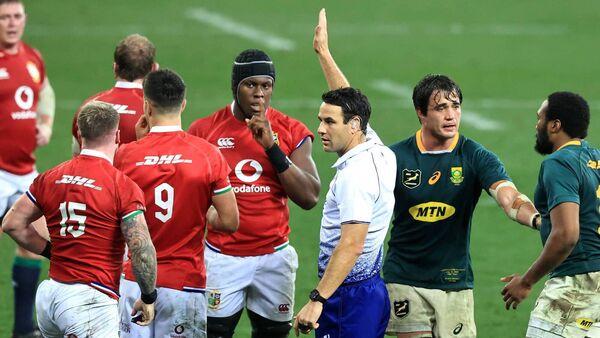Last week wasn’t a great one for international rugby, was it? Over-the-top off-field antics, a first half that lasted over an hour, and a contest that would have even the most committed purist checking if there was anything better on the telly combined to give us a very poor advertisement for the highest level of the game.
Having started with widespread praise for being magnanimous in defeat after the first Test of the series, with Rassie Erasmus declaring on Twitter that the South Africans had “no complaints” about the result, things got uglier as the week went on. What followed was a seemingly coordinated assault by Springbok players and coaches on the ability and impartiality of the officials that began in somewhat entertaining fashion but got seriously out of hand from there.
Those of us active on social media found it hilarious that Rassie was retweeting videos from an account that had only ever posted about sides that Rassie himself had been involved with, and was clearly using footage that came from the Springbok camp to highlight various perceived errors made by referee Nic Berry in the course of the match.
The addition of a bit of spice to proceedings is often welcomed as it adds another dimension to matchday preparation. Usually, it’s harmless, generates some column inches, and that’s it. But this was different. It consumed the week’s coverage and took the shine off what otherwise would have been an enjoyable build up to a must-win game for the Springboks.
In the Friday press conference, Siya Kolisi claimed Nic Berry didn’t respect him during the game. When asked for examples, he didn’t provide any. Assistant coach Mzwandile Stick followed this up by saying that questioning the appointment of Marius Jonker as TMO (by the Lions) had “destroyed the integrity of the series”.
The low point came in the form of a bizarre hour-long video that went through every incorrect refereeing decision that was made the previous weekend. Coaches often compile clips to send to referees after games in an effort to get clarity around certain decisions and inform better practice going forward. To post such a lengthy, detailed, and critical video online for public consumption was unprecedented and was clearly designed to get inside the heads of the officials.
I thought it was overkill, and that the officials would go out of their way to avoid giving the impression that the plan had worked. But you look at Cheslin Kolbe staying on the field after taking Conor Murray out in the air and causing him to narrowly avoid landing head first on the turf — a red-card offence every day of the week — and you can legitimately ask if a lingering doubt was planted by the antics in the South African camp during the week.
If it worked, I’m sure they couldn’t care less if people like me are tut-tutting and shaking our heads disapprovingly.
At the end of the day, the result matters above all else.
Kolbe wasn’t the only player lucky to avoid harsher sanctions. Vunipola, de Klerk, Itoje, and Mbonambi did well to avoid the citing commissioner — bizarrely, Kyle Sinckler is the only one facing further investigation. This has left many people scratching their heads and questioning if the criteria being used to examine incidents after the game is really being adhered to.
Most of us like seeing a bit of niggle during a game, but dangerous play that has the potential to seriously injure players — particularly anything to do with the head and neck — has to be punished to the letter of the law.
Anything less is irresponsible and puts players at risk. And let’s be honest, Test rugby has proven to be a dangerous enough arena for players as it is.
The game itself was an awful spectacle. There was little to no free-flowing rugby on show, with much of the game being played with the ball in the air. I predicted last week that the Lions would kick more aggressively in attack, given they had some success doing so in the first encounter.
They did, but this time South Africa’s aerial game was back to the levels that saw them win the 2019 World Cup.
The Lions came off second best in virtually every aerial contest, and, while the bounce of the ball played its part at times, much of this was down to the Lions’ back three being outclassed by their opponents. Stuart Hogg had an uncharacteristically poor day under the high ball, and almost perfect performances off the boot from Faf de Klerk and Handre Pollard saw the Lions backfield in disarray on multiple occasions.
I was shocked to read that Dan Biggar only threw three passes in the entire game. Three passes. If your out-half is only passing the ball three times, something is seriously wrong.
This must be the biggest concern heading into this weekend. I understand that it can be pragmatic to kick almost everything to get the upperhand on your opposition. In essence, that is what South Africa often do themselves. It’s textbook Rassie Erasmus. But you need to be able to change approach when it’s not working. The Lions relied too heavily on a single strategy and, strangely for a team with such depth of talent, had no plan B.
While the backline didn’t have its best outing, the pack was comprehensively beaten up in almost every facet of the game. The set-piece was under a huge amount of pressure for 80 minutes. At scrum time, the Lions conceded penalties at crucial, momentum-defining moments and looked under pressure throughout the game. The bigger concern will have been the lineout, however, in both attack and defence.
The issue they had on Saturday is similar to that faced by many teams these days.
In recent years there has been a shift in the approach to lineout calling. There now seems to be an obsession with winning the ball at the tail. There were multiple examples of Itoje calling ball to the back even when the zone was heavily marked. I couldn’t fault many of the throws from the hookers that were intercepted; they were picked off by well-placed defenders. Callers need to adapt in these situations and be content with winning the ball where the space is, even if that means doing so closer to the front.
The Lions were bullied at the maul, something that could take a psychological toll heading into the final Test.
While Mapimpi and Om’s tries will rightly be remembered for beautiful pieces of kicking and excellent finishes, maul drives that saw the Lions pack marched back 10m to 15m preceded both of them.
Having been relatively ineffective in the first Test, South Africa’s ‘bomb squad’ added an enormous amount of power and brutality in the third and fourth quarters, and nowhere was this seen more acutely than at maul time.
Particular credit has to go to Trevor Nyakane, who switched from tighthead to loosehead for last weekend’s game. This is a challenging thing to do at club level, let alone against the best-combined front row that four countries have to offer.
The image of him sticking out his frighteningly long tongue as he celebrated winning a scrum penalty in the 75th minute has to be one of the most memorable sights of what has been a fairly forgettable Test series so far.
Heading into the third match, I’m not terribly optimistic for the Lions. They regressed in a big way from the performance in the first Test, and South Africa have clearly moved in the opposite direction. The Lions will have to ring the changes to give themselves a fighting chance, something that always has the potential to be as disruptive as it is beneficial.
The Springboks will be largely unchanged, and will approach the game in the exact same way, buoyed by the dominance they enjoyed last weekend.
Hopefully, we will get to enjoy a cracker of a final contest this weekend. Everything is set up nicely for a grand finale, and it would be some consolation for supporters that have followed the tour closely from day one to be treated to a game that shows how entertaining international rugby can and should be, whatever the final result.

